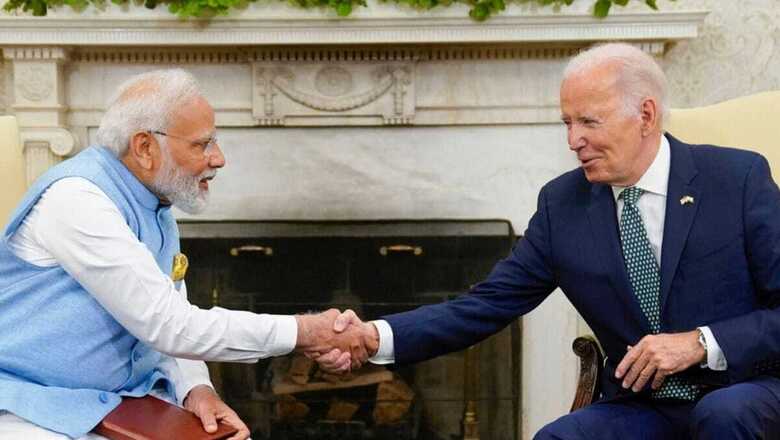
views
As Prime Minister Narendra Modi embarks on a state visit to the United States, the Western media seems to be on an anti-India overdrive. The latest being The New York Times article, ‘In Hosting Modi, Biden Pushes Democracy Concerns to the Background’, by Peter Baker and Mujib Mashal.
On the US administration rolling the red carpet for PM Modi, the article adopts a combative approach from the very beginning. It writes how President Joe Biden, who categorically wanted “the battle between democracy and autocracy” to be the defining struggle of his regime, has compromised “to accept some imperfect but important friends”. The article goes on to say that the Modi government “has cracked down on dissent and hounded opponents in a way that has raised fears of an authoritarian turn not seen since India’s slip into dictatorship in the 1970s”.
Earlier this month, the NYT ran an article bemoaning “A Shrinking Space For Dissent’, on its front page with a photo of the wrestlers’ protest. However, to think that the NYT alone is targeting PM Modi and India with prejudice and hatred that should ideally be reserved for a dictatorship in North Korea or a jihadi establishment in Afghanistan. The Time magazine, for instance, questioned the very idea of India being an American ally. “India is not a US ally, and has not wanted to become one. To see relations with rising power India as on a pathway that culminates in a relationship like that the United States enjoys with Japan or the United Kingdom creates expectations that will not be met,” Alyssa Ayres wrote on 21 June, the very day PM Modi reached the US.
Even more scathing was the June 20 article, which made a passionate plea against India being an ally of the US, citing its “worsening democracy”. The article, titled ‘India’s Worsening Democracy Makes It an Unreliable Ally’, treads the similar anti-India path as it writes, quite predictably: “The treatment of Muslims, who form 14% of India’s population, has worsened. A 2019 report by Human Rights Watch documented 44 murders (36 of them being Muslim) by lynch mobs who killed people they suspected of possessing beef, consuming it, or trading cows. Muslims find it hard to buy or rent property, are denied permission to build mosques in some cases, and prevented from praying in public. Vigilantes prevent Muslims from praying at home. Female Muslim students in one state were banned from wearing headscarves.”
One can cite one Western report after another pushing the same anti-India narrative: That India is an economic powerhouse… but it is being run by Hindu nationalists; that Modi is popular but he is authoritarian; that India is still a democracy, a flawed one of course, but the minorities, especially Muslims, are being targeted and oppressed. The above facts are like Biblical commandments, needing no proof or data whatsoever. India is condemned without being given a chance to place its defence. And all this is happening in the name of democracy and secularism.
Amol Parth, a media analyst-cum-journalist, for his 2021 article, ‘An Analysis of Global Media Coverage of Events in India’, published in The Communicator, “studied more than 3,000 India-related articles by The New York Times, Washington Post, Wall Street Journal, Time and The Guardian over the last decade”. Out of these, a total of 500 articles — hundred each from the five newspapers/magazines — were “randomly sampled”. The result: In these 500 headlines, it was found that the most used words were these 10 — Fear, Hate, Violence, Riot, Hindu, Muslim, Kashmir, Cow, Mob, and Protest.
“It can be inferred that these foreign media outlets have been trying to exploit the alleged fault lines within India, looking for controversies and potential contentious issues which may catch more eyeballs. This not only creates social unrest in India but also hurts India’s image globally, in turn putting India’s foreign relations and economic interests at risk,” Parth writes.
Ironically, the West’s own record on race and religion has been quite mediocre, if not dubious. Former Foreign Secretary Maharaja Krishna Rasgotra recalls in his 2016 memoirs, A Life in Diplomacy, how in 1953, when he first landed in the US as a young diplomat, a black cab driver refused to take him to a particular hotel. “Why? Because… his cab was only for black people!” When Rasgotra insisted, the diver pleaded: “Sir, you are new here. You don’t understand, if I drive you to the hotel, I will be beaten up, even killed by white people.”
This was the situation in the US town of Texas, not some villages in America’s Wild West — more than 175 years after its Independence and almost 88 years after the 13th Amendment abolished slavery in 1865. And if one thinks the US has become a utopian State for all communities and races, one must read the story of two white men attacking a black person with an axe late last year — just because the latter was shopping in a store the white men thought he didn’t belong to.
Statistically speaking, this year alone, in the US, a total 344 civilians have been shot, 42 of whom were Black (as of 1 May 2023). In 2022, there were 1,096 fatal police shootings, of them more than one-fifth (225) were connected with Black. In 2021, there were 1,048 fatal shootings — and 233 of them came from the Black background. The thing is when such an incident occurs in the US it becomes a crime case; but in India, the same is projected as an institutional failure, deterioration of democracy, and targeting of minorities, Dalits, et al.
The Western doublespeak on race becomes obvious when one realises that African Americans make up 13 percent of the US population “but are killed by police at more than twice the rate of white Americans”, as per a Washington Post report. Similarly, the West can put curbs on its Muslim citizens without anyone questioning its secular credentials, but even if a private educational institution in India decides to implement its dress code, as was witnessed in Karnataka last year in the hijab case, it becomes a case of slide in Indian democracy, liberalism.
Author Pallavi Aiyar exposes this Western hypocrisy in her book, Punjabi Parmesan: Dispatches from a Europe in Crisis (2014), when she writes how a 2009 Swiss ban on minarets was pushed despite the existence of just four minarets in the country; and headscarves were banned in French schools even when less than 1 percent of Muslim girls wore them. The number of women who chose to wear burqas in France before they were banned was less than 350 — a fourth of whom were converts.
Still, India would be routinely lectured on democracy, multiculturalism, secularism, human rights, etc. This double-speak was also witnessed during the so-called farmers’ agitation, when the West didn’t miss an opportunity to sermonise India on the need to allow and accept dissent, but when similar protests rocked the West, the same powers rushed to clamp them down.
Last but not the least, one needs to examine if the democratic, secular space has actually shrunk in India, as the West claims? Analyses on the three parameters — minorities, women and Dalits — on which the Modi government is mostly targeted, one gets a completely different story. Those who paint India’s anti-minority image in the name of CAA and NRC, gloss over the fact that the Modi government has spent Rs 22,000 crore on minority welfare and awarded scholarships to around 3.14 crore minority students, which is 20 lakh more than provided by the UPA-II dispensation. The minorities are also the biggest beneficiaries of the government’s MSME push, as they mostly run or work with small and medium enterprises.
On the women’s front, this is the first government that has taken up the toilet and swachhta (cleanliness) issues with the urgency they required. When Prime Minister Modi first talked about toilets during his Independence Day speech in August 2014, many eyebrows were raised. Some thought this issue didn’t deserve to be raised from the rampart of the Red Fort, but he shut the critics up by making a difference on the ground. Women, especially from villages, are the biggest beneficiaries of this scheme. As for Muslim women, triple talaq is now a thing of the past.
Coming to Dalits, another stick with which this government is often beaten and India painted in dark hues, one needs to look at the BJP’s performance among this community in Uttar Pradesh — a state where they are most assertive and politically aware. In the 2022 Assembly elections in Uttar Pradesh, for instance, the BJP won 63 out of 84 SC reserved seats. According to the CSDS post-poll study, the BJP’s Jatav base went up from 5 percent in 2012 to 21 percent in 2022, and the non-Jatav base grew from 11 percent in 2012 to 41 percent in 2022. How can a party that oppresses the Dalits and discriminates against them get this kind of support?
It’s unfortunate that the Western media, ideally a vanguard of democracy, has blinded itself to these obvious realities and is targeting a democratic miracle that India is. New Delhi may not be a Washington ally of the nature and scale of London, but the very liberal, free world temperaments of the two democracies make them natural friends who may not agree on everything but can trust each other. PM Modi’s US state visit, in that way, is historic, and the Western media should be a partner in this exercise, not an impediment.
But then, there’s a China angle to the story: A US-India alliance is the last thing the Xi Jinping administration wants. It has, therefore, activated its Trojan horses in America, and if Michael Pillsbury’s book, The Hundred Year Marathon: China’s Secret Strategy to Replace America as the Global Power (2015), is to be believed, there are many such ‘horses’ in the US deeply embedded in the administration, academia, think tanks, even Hollywood. The media is the worst hit. As per US justice department reports, the Chinese state-run daily China Daily paid millions of dollars to American publications led by Time magazine, Washington Post, Wall Street Journal, The New York Times, Financial Times, Foreign Policy, and Los Angeles Times.
This explains the kind of hostility Prime Minister Modi is facing in the US despite the Biden administration (there’s still a section within the administration that is anti-India) apparently willing to accommodate India’s interests. The two nations have missed several buses in the past, this one cannot be allowed to forego. The time is ripe to take India-US relations to new heights.
The author is Opinion Editor, Firstpost and News18. He tweets from @Utpal_Kumar1. Views expressed are personal.




















Comments
0 comment